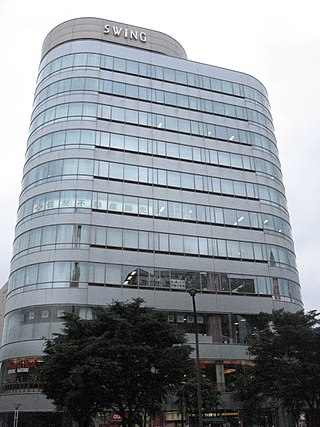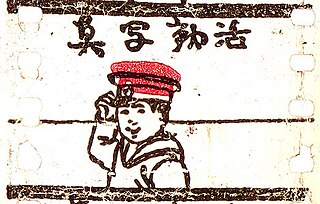Related Research Articles
Anime is hand-drawn and computer-generated animation originating from Japan. Outside of Japan and in English, anime refers specifically to animation produced in Japan. However, in Japan and in Japanese, anime describes all animated works, regardless of style or origin. Animation produced outside of Japan with similar style to Japanese animation is commonly referred to as anime-influenced animation.
The history of anime can be traced back to the start of the 20th century, with the earliest verifiable films dating from 1907. Before the advent of film, Japan already had a rich tradition of entertainment with colourful painted figures moving across the projection screen in utsushi-e (写し絵), a particular Japanese type of magic lantern show popular in the 19th century. Possibly inspired by European phantasmagoria shows, utsushi-e showmen used mechanical slides and developed lightweight wooden projectors (furo) that were handheld so that several performers could each control the motions of different projected figures.

Toei Animation Co., Ltd. is a Japanese animation studio primarily controlled by its namesake Toei Company. It has produced numerous series, including Sally the Witch,GeGeGe no Kitarō,Mazinger Z, Galaxy Express 999, Cutie Honey, Dr. Slump, Dragon Ball, Saint Seiya, Sailor Moon, Slam Dunk, Digimon, One Piece, Toriko, World Trigger, The Transformers and the Pretty Cure series.

Amblin Entertainment, Inc., formerly named Amblin Productions and Steven Spielberg Productions, is an American film production company founded by director and producer Steven Spielberg, and film producers Kathleen Kennedy and Frank Marshall in 1980. Its headquarters are located in Bungalow 477 of the Universal Studios backlot in Universal City, California. It distributes all of the films from Amblin Partners under the Amblin Entertainment banner.

Cutout animation is a form of stop-motion animation using flat characters, props and backgrounds cut from materials such as paper, card, stiff fabric or photographs. The props would be cut out and used as puppets for stop motion. The world's earliest known animated feature films were cutout animations, as is the world's earliest surviving animated feature Die Abenteuer des Prinzen Achmed (1926) by Lotte Reiniger.

Madlax is a 26-episode Japanese anime television series produced in 2004 by the Bee Train animation studio. Kōichi Mashimo directed Madlax and the soundtrack was composed by Yuki Kajiura. The DVD version was released by ADV Films in North America and the United Kingdom and by Madman Entertainment in Australia and New Zealand.

J.C.Staff Co., Ltd., is a Japanese animation studio founded in January 1986 by Tomoyuki Miyata, who previously worked at Tatsunoko Production. The studio's first release was Yōtōden in 1987. They have produced several well-known anime series, such as Food Wars!: Shokugeki no Soma, the A Certain Magical Index franchise, Date A Live III, Toradora!, The Disastrous Life of Saiki K., Maid Sama!, The Familiar of Zero, Revolutionary Girl Utena, Bakuman, Shakugan no Shana, Azumanga Daioh, and One-Punch Man season 2.

Walter Ruttmann was a German cinematographer and film director, an important German abstract experimental film maker, along with Hans Richter, Viking Eggeling and Oskar Fischinger. He is best known for directing the semi-documentary 'city symphony' silent film, with orchestral score by Edmund Meisel, in 1927, Berlin: Symphony of a Metropolis. His audio montage Wochenende (Weekend) (1930) is considered a major contribution in the development of audio plays.

The Animation of the Year (アニメーション作品賞) of the Japan Academy Film Prize is one of the annual Awards given by the Japan Academy Film Prize Association.

Katsudō Shashin, sometimes called the Matsumoto fragment, is a Japanese animated filmstrip that is the oldest known work of animation from Japan. Its creator is unknown. Evidence suggests it was made before 1912, so it may predate the earliest displays of Western animated films in Japan. It was discovered in a collection of films and projectors in Kyoto in 2005.
Urashima Tarō (浦島太郎) is a Japanese animated film produced by Seitaro Kitayama in 1918. The film is an adaptation of a folk tale Urashima Tarō about a fisherman traveling to an underwater world on a turtle. It premiered in February 1918, making it one of the earliest anime films.

The Tatami Galaxy is a 2004 Japanese varsity novel written by Tomihiko Morimi and published by Ohta Publishing. Its first-person narrator is an unnamed upperclassman at Kyoto University reminiscing on the misadventures of his previous years of campus life, with each of the four chapters taking place in parallel universes in which he is enrolled in a different student society.

Telecom Animation Film Co., Ltd. is a Japanese animation studio founded on May 19, 1975 and currently affiliated with TMS Entertainment. The company produces television series, films, and original video animations (OVA).
Seitarō Kitayama was an early Japanese animation director whose work includes the first examples of commercial production of anime. Kitayama was referred to as one of the fathers of anime by Yoshirō Irie, a researcher at Japan's National Film Center.
Seitarō, Seitaro or Seitarou is a masculine Japanese given name. Notable people with the name include:
The Tale of Genji is a 1987 animated adaptation of The Tale of Genji, directed by Gisaburō Sugii.
References
- ↑ "Seitaro Kitayama | List of Authors | Japanese Animated Film Classics". animation.filmarchives.jp. Retrieved 2021-09-14.
- ↑ Brashear, Laurie. "LibGuides: Film and Media Studies: Japanese Animation". eac.libguides.com. Retrieved 2021-09-14.
- ↑ "The History of Anime: The Beginnings - Learn more at Japan Centric". Japan Centric. 2020-03-08. Retrieved 2021-09-14.